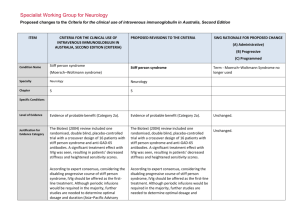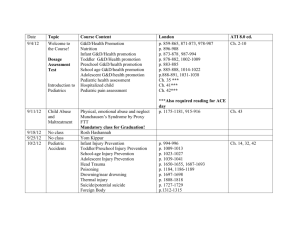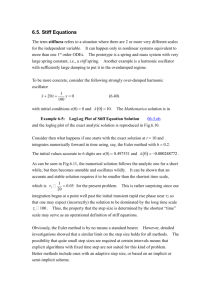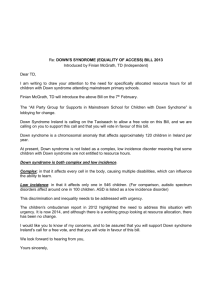Stiff person syndrome
advertisement
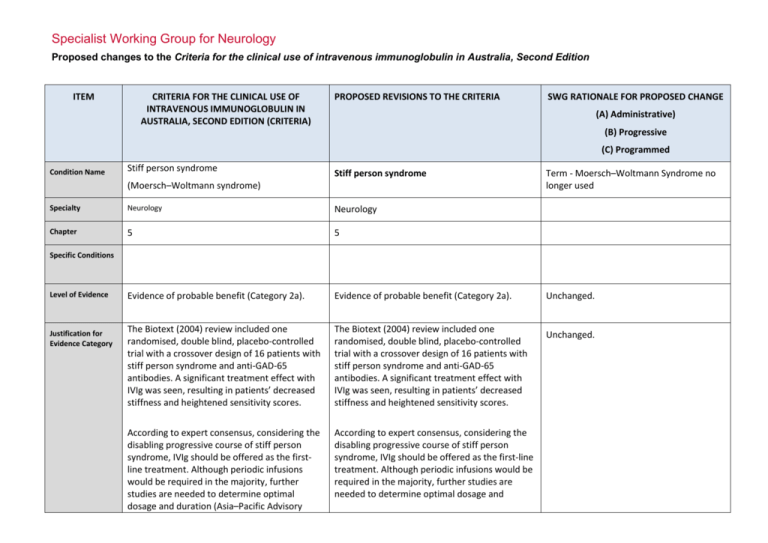
Specialist Working Group for Neurology Proposed changes to the Criteria for the clinical use of intravenous immunoglobulin in Australia, Second Edition ITEM CRITERIA FOR THE CLINICAL USE OF INTRAVENOUS IMMUNOGLOBULIN IN AUSTRALIA, SECOND EDITION (CRITERIA) PROPOSED REVISIONS TO THE CRITERIA SWG RATIONALE FOR PROPOSED CHANGE (A) Administrative) (B) Progressive (C) Programmed Condition Name Stiff person syndrome Stiff person syndrome (Moersch–Woltmann syndrome) Specialty Neurology Neurology Chapter 5 5 Evidence of probable benefit (Category 2a). Evidence of probable benefit (Category 2a). The Biotext (2004) review included one randomised, double blind, placebo-controlled trial with a crossover design of 16 patients with stiff person syndrome and anti-GAD-65 antibodies. A significant treatment effect with IVIg was seen, resulting in patients’ decreased stiffness and heightened sensitivity scores. The Biotext (2004) review included one randomised, double blind, placebo-controlled trial with a crossover design of 16 patients with stiff person syndrome and anti-GAD-65 antibodies. A significant treatment effect with IVIg was seen, resulting in patients’ decreased stiffness and heightened sensitivity scores. According to expert consensus, considering the disabling progressive course of stiff person syndrome, IVIg should be offered as the firstline treatment. Although periodic infusions would be required in the majority, further studies are needed to determine optimal dosage and duration (Asia–Pacific Advisory According to expert consensus, considering the disabling progressive course of stiff person syndrome, IVIg should be offered as the first-line treatment. Although periodic infusions would be required in the majority, further studies are needed to determine optimal dosage and Term - Moersch–Woltmann Syndrome no longer used Specific Conditions Level of Evidence Justification for Evidence Category Unchanged. Unchanged. Description and Diagnostic Criteria Board 2004). duration (Asia–Pacific Advisory Board 2004). Patients with stiff person syndrome present with symptoms related to muscular rigidity and superimposed episodic spasms. The rigidity insidiously spreads involving axial muscles, primarily abdominal and thoracolumbar, as well as proximal limb muscles. Typically, cocontraction of truncal agonist and antagonistic muscles leads to a board-like appearance with hyperlordosis. Less frequently, respiratory muscle involvement leads to breathing difficulty and facial muscle involvement to a mask-like face. Patients with stiff person syndrome present with symptoms related to muscular rigidity and superimposed episodic spasms. The rigidity insidiously spreads involving axial muscles, primarily abdominal and thoracolumbar, as well as proximal limb muscles. Typically, cocontraction of truncal agonist and antagonistic muscles leads to a board-like appearance with hyperlordosis. Less frequently, respiratory muscle involvement leads to breathing difficulty and facial muscle involvement to a mask-like face. Investigations that may be useful for diagnosis include auto-antibodies to GAD-65 or GAD-67, electromyography recordings from stiff muscles that may show continuous discharges of motor unit, and cerebrospinal fluid oligoclonal bands. Investigations that may be useful for diagnosis include auto-antibodies to GAD-65 or GAD-67, electromyography recordings from stiff muscles that may show continuous discharges of motor unit, and cerebrospinal fluid oligoclonal bands. Diagnosis is required No By which speciality Diagnosis must be verified No By which speciality Unchanged. Exclusion Criteria Indications Treatment of significant functional impairment in patients who have a verified diagnosis of stiff person syndrome. Stiff Person Syndrome or variants with significant disability Change Revise ‘impairment’ to ‘disability’ and to include variants. Rationale Reworded for consistency with other indications - modifying language to ‘disability’ and appropriately indicating that National Blood Authority pg. 2 variants are eligible for treatment Qualifying Criteria Significant functional impairment in patients who have a verified diagnosis of stiff person syndrome made by a neurologist. Stiff Person Syndrome or variants with significant disability Neurologist confirmed diagnosis of Stiff Person Syndrome or its variants with significant disability as measured by the Modified Rankin Functional ADL Score of at least 4 points and the Distribution of stiffness index of at least 1 point. The Ig governance program requires formal eligibility criteria with supporting evidence to be defined for each condition. Eligibility is to be confirmed by Modified Rankin and Distribution of Stiffness Index because these methods have been demonstrated as effective through Randomised Controlled Trials. References: Rankin J. “Cerebral vascular accidents in patients over the age of 60.” Scott Med J 1957;2:200-15 Bonita R, Beaglehole R. “Modification of Rankin Scale: Recovery of motor function after stroke.” Stroke 1988 Dec;19(12):1497-1500 Van Swieten JC, Koudstaal PJ, Visser MC, Schouten HJ, van Gijn J. “Interobserver agreement for the assessment of handicap in stroke patients. Original version of Modified Rankin has been shortened to display more easily in the list of values. Review Criteria Review Regular review by a neurologist is required; frequency as determined by clinical status of patient. For stable patients on maintenance treatment, review by a neurologist is required at least annually. Effectiveness Objective indicators of relief of symptoms of stiffness, including: •improvement or stabilisation of activities of National Blood Authority Stiff Person Syndrome or variants with significant disability Review Preamble Regular review by a neurologist is required within 6 of the initial review and at least annually thereafter. On review of the Initial Authorisation Period Patient demonstrates relief of symptoms of pg. 3 daily living scores; •other specialised scoring systems, such as distribution-of-stiffness index and heightened sensitivity scale. stiffness and disability as demonstrated by a Functional Assessment ADL - Modified Rankin Score and a Distribution of Stiffness Index which are greater than the qualifying scores. On review of a Continuing Authorisation Period Patient demonstrates stable symptoms of stiffness demonstrated by a Functional ADL Score – Modified Rankin which is greater than or equal to the scores at the last review and greater than the qualifying scores. Review Postscript For stable patients on maintenance treatment, review by a neurologist is required at least annually. Dose Induction: 2 g/kg in 2 to 5 divided doses. Maintenance: 1–2 g/kg, 4–6 weekly. Aim for the minimum dose to maintain optimal functional status. Dosing above 1 g/kg per day is contraindicated for some IVIg products. Refer to the current product information sheet for further information. The aim should be to use the lowest dose possible that achieves the appropriate clinical outcome for each patient Stiff person Syndrome with significant functional impairment There will be a lower limit defined as 1g for induction dose. Induction: Up to 2 g/kg in 2 to 5 divided doses Maintenance While maximum dosing is unchanged, prescribers are encouraged to titrate the dose to the individual’s response and supported in giving divided doses more frequently than monthly. Maintenance: Up to 0.4–1 g/kg, 2–6 weekly. The amount per dose should be titrated to the individual’s response. A maximum dose of 2 g/Kg may be given in any 4 week period. This might be by divided doses more frequently than monthly. [Dose Postscript] The aim should be to use the lowest dose possible that achieves the appropriate clinical outcome for each patient. Dosing above 1 g/kg per day is contraindicated for some IVIg products and in some patients ( National Blood Authority pg. 4 Prompt to remind patients regarding thrombotic risk of Ig. see product information). Refer to the current product information sheet for further information. National Blood Authority pg. 5 POTENTIAL OPERATIONAL IMPACT Given that Stiff Person Syndrome is very rare, diagnosis is already likely to be made by neurologists. Where patients are in the care of a general physician, transfer will be required to a neurologist. It is important that patients will have given informed consent to Ig treatment, which includes understanding that a measurable clinical response will determine continuing eligibility. Patients not demonstrating a satisfactory response will cease therapy at 6 months. Clinicians may opt for more frequent dosing to improve clinical outcome in patients - this may have an impact on scheduling of appointments. POTENTIAL IMPACT ON DEMAND POTENTIAL IMPACT ON DEMAND Patient Numbers 2013-14 41 <1% Given the few patients with this condition it is unlikely that there will be any significant impact on demand. Usage 13/14 POTENTIAL IMPACT ON COST Current cost Anticipated reduction in cost, if any Marginal Marginal = borderline or unchanged from current cost Minor = decrease by $500K - $1.99M from current cost Major = decrease $2M+ from current cost BIBLIOGRAPHY Biotext 2004, ‘Summary data on conditions and papers’, in A systematic literature review and report on the efficacy of intravenous immunoglobulin therapy and its risks, commissioned by the National Blood Authority on behalf of all Australian Governments, pp. 190–1. Available from: www.nba.gov.au/pubs.htm [cited 7 Dec 2007] Dalakas, MC 2005, ‘The role of IVIg in the treatment of patients with stiff person syndrome and other neurological diseases associated with anti-GAD antibodies’, National Blood Authority pg. 6 Journal of Neurology, vol. 252, suppl. 1, pp. 119–25. Dalakas, MC, Fujii, M, Li, M, et al 2001, ‘High-dose intravenous immune globulin for stiff-person syndrome’ [see comment], New England Journal of Medicine, vol. 345, no. 26, pp. 1870–6. Kornberg, AJ, for the Asia–Pacific IVIg Advisory Board 2004, Bringing consensus to the use of IVIg in neurology. Expert consensus statements on the use of IVIg in neurology, 1st edn, Asia–Pacific IVIg Advisory Board, Melbourne, pp. 70–2. Rowland, LP & Layzer RB 2005, ‘Stiff man syndrome (Moersch– Woltman syndrome)‘, in LP Rowland (ed.), Merritt’s Neurology, 11th edn, Lippincott Williams & Wilkins, Philadelphia, p. 927. END OF DOCUMENT National Blood Authority pg. 7
